|
|

Annantalo Arts Centre, Helsinki. Their Japan Day event was held on April 9, 2006.A former primary school built in 1886, this distinguished-looking building is now an arts center for children and young people. They held a Japan Day event on April 9, 2006 when they presented Budo demonstrations, kimono show, workshops, Japanese food, lectures, and a photo exhibition featuring my pictures of Japanese costumes. My friend Elina Moriya also showed a few of her pictures of temples.
Annantalo Web site: [url=http://www.kulttuuri.hel.fi/annantalo/index_en.html[/url]
|
|

Japan Day Opening Ceremony with the Japanese ambassador to Finland and his wife sitting front and center.On Ambassador Kondo's left is Mrs. Johanna Lindstedt, the director of Annantalo, and next to her is Ronny Rönnqvist, the chairman of the Friends of Japanese Culture Society which was the co-organizer of the Japan Day event.
|
|
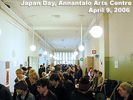
The entire building is jam-packed. This is the bazaar section.
|
|
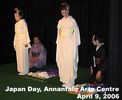
Kimono demonstration attracted the most attention. Many people could not enter the auditorium to see this.
|
|
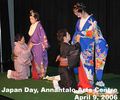
A total of 10 local Finnish women modeled the kimono.
|
|

Kimono demonstration
|
|

Kimono demonstration
|
|

Budo booth
|
|

Shodo calligraphy lesson
|
|

Flower arrangement lesson
|
|
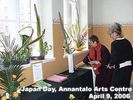
Completed flower arrangements.
|
|

Photo exhibition room with "Japanese Costume" photos by Philbert Ono.
|
|

People crowding the photo exhibition room with "Japanese Costume" photos by Philbert Ono.
|
|
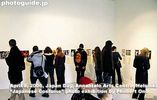
A steady stream of people came to see the exhibition of about 30 pictures.
|
|
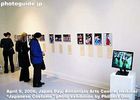
My video clips of Japanese festivals were also shown by a monitor.
|
|
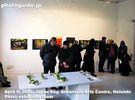
One wall also showed photos of Japanese temples by Elina Moriya, a Helsinki-based Japanese-Finnish photographer.So it was actually a joint photo exhibition by Philbert and Elina. How about that... When I first met Elina, I never dreamed something like this would happen.
|
|

Japan Day announcement in Helsingin Sanomat, Helsinki's leading newspaper.The announcement was one-fourth page. My two photos contrasted between the traditional and pop cultures.
|
|

In case you missed the exhibition, you can see most of the pictures on this page. Lion Dance above.From a kabuki dance called Renjishi, this is one of Japan's most famous and dramatic costumes. The dance is usually performed by a father and son both appearing first as ordinary dancers holding a lion mask. Later, they transform into fierce-looking lions, the father with long white hair and the son with long red hair. The dance climaxes with both father and son spinning their hair furiously in the air accompanied by quick drum beating and music. A similar kabuki dance called Kagamijishi features only the white lion.
|
|
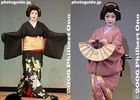
Kagurazaka Geisha Dance, TokyoMost people associate the geisha with Kyoto. However, Tokyo also has authentic geisha. Kagurazaka is one of the few remaining geisha districts in Tokyo. The Kagurazaka geisha give public dance performances in spring called "Hana no Kai" (Glamorous Gathering). They have proven to be very popular with sold-out performances every year. The geisha change into different kimono as they perform graceful dances and musical plays.
See more photos of this dance here.
|
|
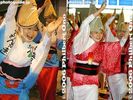
Awa Odori Dance, Koenji, TokyoThe Awa Odori is a summer dance festival originally from Tokushima Prefecture in Shikoku. It has spread to other cities such as Koenji, Tokyo and Yamato, Kanagawa Prefecture. It is a simple dance accompanied by an infectious drum beat. The hands are raised above the head and shaken. It is the same gesture as saying, "I'm a fool." Hence, it is nicknamed the "Fool's Dance." It is originally a Buddhist bon dance held in August to welcome back the souls of the deceased returning to visit Earth. The crescent moon-shaped straw hat is one symbol of the dance.
|
|
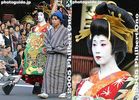
Oiran Courtesan Procession, TokyoOn Nov. 3, Japan's Culture Day holiday, the Tokyo Festival of the Ages (Jidai Matsuri) is held in Asakusa, Tokyo. It is a long parade of people dressed in historical costumes tracing the history of Tokyo. One highlight is the Oiran Dochu, a procession for a high-ranking courtesan called "oiran." One of the trademarks of the oiran was her very high and heavy platform clogs. She walks in a very stylized figure 8 pattern. Her hair also has many ornaments.
See more photos of this festival here.
|
|
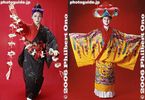
Okinawan KimonoOkinawa is a chain of subtropical islands in southern Japan between Kyushu and Taiwan. It developed its own language and culture while it was an independent kingdom centuries ago. Okinawan kimono, hairstyles, and dances therefore look quite different from the rest of Japan.
On the left is an Okinawan dancer wearing a kimono with her right arm exposed outside the sleeve. The dance is called "Nuchibana" (flower lei) featuring a string of red and white flowers. The dance expresses the feelings of a young woman in love.
The dancer on the right is wearing an Okinawan kimono called the bingata, perhaps Okinawa's most famous kimono. The design is made by applying dyes through a stencil. It was originally worn by Okinawa's royal family members. It is now the costume of a slow-moving Okinawan dance called "Yotsudake."
|
|

Costume PlayersJapan has long been home to anime cartoons, manga comics, and video games. But it was only from the mid-1990s when it became very popular for teenagers and young women to dress up as characters from their favorite anime, manga, or video game. They congregate at manga, video game, and anime fairs where they pose for hordes of photographers.
They either buy or make their costumes. They depict so many characters that it's impossible to recognize all of them unless you ask them who they are costumed as. The girl on the left is dressed as Felicia from Vampire Savior.
See more photos of cosplayers here.
|
|
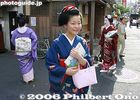
Geisha and Maiko in KyotoThis is in Pontocho, one of Kyoto's geisha districts. The woman on the left is a geisha (called "geiko" in Kyoto), the woman in the middle is a helper, and the woman on the right is a maiko or apprentice geisha. They are on their way to see the Kamogawa Odori dance performed by the Pontocho geisha in May.
|
|

Back of a Maiko, KyotoThe maiko is an apprentice geisha (or geiko). She can be easily identified by the long length of her kimono sleeves and the long length of her obi sash on her back.
See more photos of Kyoto geisha here.
|
|

Kamogawa Odori Geisha Dance, KyotoA scene from the annual Kamogawa Odori dance held in May in Kyoto. She wears a multi-layer kimono whose colors contrast well with each other. This type of kimono was worn by the nobility.
See more photos of this dance here.
|
|

Aoi Festival, KyotoHeld in May, the Aoi (Hollyhock) Festival is one of Kyoto's Big Three festivals. It is a long parade of people dressed in historical costumes from the Heian Period (794-1185) when Kyoto was Japan's capital. Each participant also wears a small branch of hollyhock.
See more photos of this festival here.
|
|

Aoi Festival, KyotoThe parade proceeds through a long route in Kyoto, taking a few hours.
See more photos of this festival here.
|
|

Awa Odori Dance, Yamato, KanagawaThe city of Yamato in Kanagawa Prefecture holds its annual Awa Odori dance during the last weekend in July. Numerous Awa Odori dance troupes (including those from Tokushima) participate in the evening dance parade in the city's main streets.
|
|

Awa Odori Dance, Yamato, KanagawaAwa Odori dancers are characterized by their straw hats, a thin kimono called the yukata, and geta clogs. Their heels don't touch the ground, so they dance on their toes. They hop along while shaking their hands above their heads. Since the dance is performed in the summer, often the yukata gets soaked with perspiration.
|
|

Awa Odori Dance, Koenji, TokyoIn late August, Koenji in Tokyo holds one of the largest Awa Odori dances outside Tokushima Prefecture. This woman is a different type of Awa dancer. She wears a head band, a happi coat imprinted with the name of her dance troupe, a pair of white shorts, and a pair of white sock-like shoes called tabi.
|
|

Awa Odori Dance, Yamato, KanagawaThe dance is accompanied by taiko drums and other traditional music. This woman was strong enough to be "one of the drum boys." She wears a head band and a full-length yukata.
|
|

Hanagasa Festival, YamagataDuring early August, northern Japan holds several large-scale summer festivals. One of them is the Hanagasa (Flower Hat) Festival in Yamagata city. Held in the evening, it is a long parade of women dancing while wearing a flowered hat.
See more photos of this festival here.
|
|

Tekomai Children, Hie Shrine, TokyoHie Shrine in Tokyo holds the annual Sanno Festival in June. It consists of a parade and ceremony at the shrine. These children are dressed as tekomai geisha who originally provided side entertainment at festivals.
|
|

Tekomai Geisha, Fukagawa Hachiman Festival, TokyoTomioka Hachimangu Shrine in Fukagawa, Tokyo holds the full-scale Fukagawa Hachiman Festival every three years in August. It is a parade of over 50 portable shrines preceded by a troupe of tekomai geisha.
Their colorful costume is partially masculine with trousers instead of skirts. Their right shoulder is "exposed" to show a peony flower design. They carry a red paper lantern imprinted with their names and use their right hand to drag along a metal wand. As they walk, they only sing traditional chant-like songs. They do not dance.
See more photos of this festival here.
|
|

Shinto Shrine Maidens, Taga Taisha Shrine, Shiga PrefectureMany Shinto shrines in Japan employ female attendants called "miko." They perform ceremonial dances, clean the shrine grounds, and sell charms at the shrine's gift shop. The shrine maiden's standard costume consists of a short, white kimono worn over a scarlet-red hakama (skirt-trousers). They usually wear their hair long, bundled on the back.
This picture was taken on New Year's Day when many people in Japan visit shrines to pray for a happy and safe new year. They perform a dance on the shrine's outdoor stage.
See more photos of this shrine here.
|
|
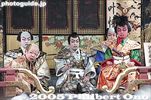
Hikiyama Festival, Nagahama, Shiga PrefectureHeld in mid-April, the Hikiyama Festival features authentic kabuki plays performed by young boys. Several ornate floats on wheels move around the city to serve as portable stages for these well-trained actors. The boys play both the male and female roles and wear gorgeous kimono. They undergo rigorous practice sessions during the months before the festival.
See more photos of this festival here.
|
|

Costume PlayerIn Tokyo, large anime and manga fairs are held at convention halls such as Tokyo Big Sight and Makuhari Messe. Many cosplayers also attend these events and pose for photographers. You can see many anime, manga, and video game characters come to life in an incredible array of costumes.
See more photos of cosplayers here.
|
|

Costume PlayerA vampiress.
See more photos of cosplayers here.
|
|

Costume PlayerPurin from Pokemon.
See more photos of cosplayers here.
|
|

Costume PlayerCosplay costumes are sometimes based on Japanese kimono and Japanese elements such as the cherry blossom. She's Sakura Shinguuji from a video game called Sakura Wars (Sakura Taisen).
See more photos of cosplayers here.
|
|
|
|
|
|
|